
Weevils are beetles belonging to the superfamily Curculionoidea, known for their elongated snouts. They are usually small – less than 6 mm in length – and herbivorous. Approximately 97,000 species of weevils are known. They belong to several families, with most of them in the family Curculionidae. It also includes bark beetles, which while morphologically dissimilar to other weevils in lacking the distinctive snout, is a subfamily of Curculionidae. Some other beetles, although not closely related, bear the name "weevil", such as the biscuit weevil, which belongs to the family Ptinidae.
Elwood Curtin Zimmerman was an American entomologist best known for his two multivolume series: Insects of Hawaii published by the University of Hawaiʻi Press and Australian Weevils published by Australia's CSIRO.

Phyllobius glaucus is a species of weevil found across Europe, especially in carrs. It is a pest of a variety of fruit trees, but has little economic effect. It was first described by Giovanni Antonio Scopoli in 1763.
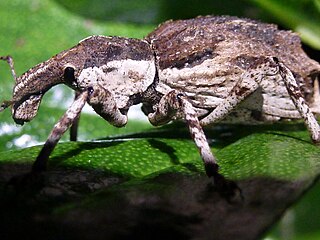
Anagotus stephenensis, commonly known as the ngaio weevil, is a large flightless weevil that is only found on Stephens Island in New Zealand. The ngaio weevil was discovered in 1916 by A.C. O'Connor on Stephens Island. Thomas Broun described it in 1921 as Phaeophanus oconnori after its collector. The weevils were observed at the time to be 'feeding on tall fescue and the leaves of trees'.
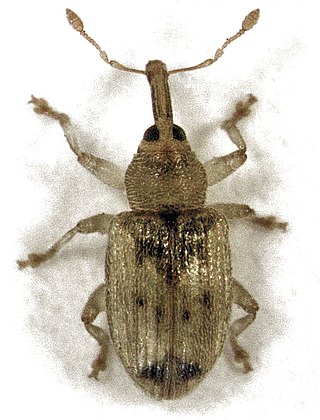
Peristoreus stramineus is a species of true weevil. It is endemic to New Zealand. The larvae develop in flower buds of Hoheria populnea.
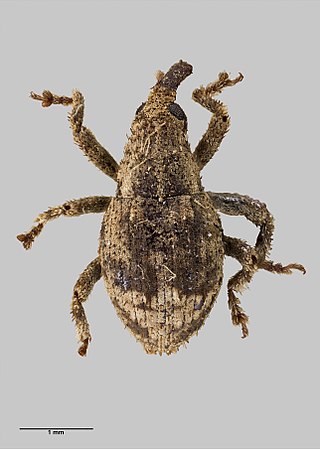
Didymus metrosideri is an endemic weevil from the Kermadec Islands in New Zealand. This species was discovered by W. L. Wallace during the 1908 Kermedec Islands expedition.
Ceutorhynchus elegans is a species of true weevils in the tribe Ceutorhynchini. It has a palaearctic distribution.

Apion ervi is a species of seed weevils native to Europe.
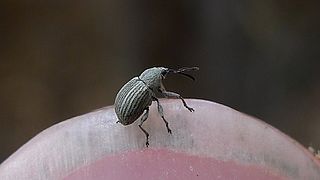
Apion ulicis is a species of seed weevils native to Europe.

Apion apricans is a species of seed weevils native to Europe. It is widespread everywhere. Damages clover and wild. The beetle is 3–3.5 mm in size, black, with a metallic hue, the body is pear-shaped, the legs are partially yellow; rostrum long, almost straight; apex of antennae black, base - red. Egg - 0.3-0.5 mm, yellowish, long, smooth. Larva 2–2.5 mm, white with a creamy hue, curved, dark brown head, on the upper jaws on each side of three growths, the middle of them increased; instead of legs six pairs of small knolls. Pupa 3–3.5 mm, yellowish white.
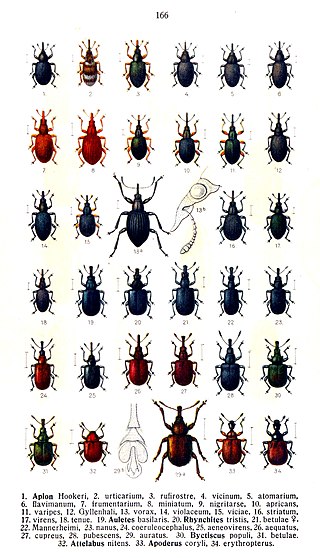
Apion nigritarse is a species of seed weevils native to Europe.

Apion vorax is a species of seed weevils native to Europe.

Apion virens is a species of seed weevils native to Europe.

Apion viciae is a species of seed weevils native to Europe.

Apion pisi is a species of seed weevils native to Europe. It is phytophagous and a pest of lucerne

Pseudaplemonus limonii is a species of weevil from the Apioninae subfamily. It lives on Common sea-lavender on the coasts of western Europe and northwest Africa.

Trichapion is a genus of weevil in the family Brentidae.

Trichapion rostrum, the baptisia seed pod weevil or wild indigo weevil, is a species of weevil in the family Brentidae.
Cossonus disciferus, is a species of weevil found in Sri Lanka.

Metapion is a genus of beetles belonging to the family Brentidae. The species of this genus are distributed only in the Palearctic zone and likely originate from deserts of Central Asia. They are commonly found in Southern Europe, northern parts of the Middle East, Caucasus and in Central Asia. Some species also appear in northern zones of Africa.












